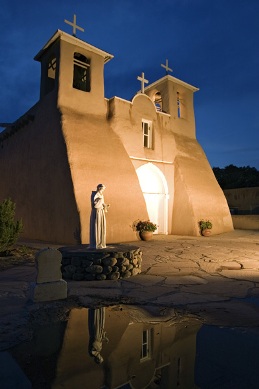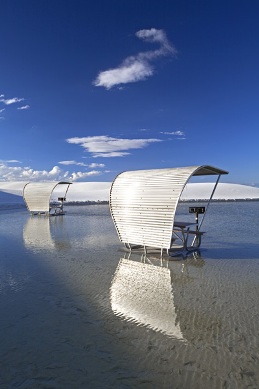Professional photographer Efrain Padro and staff writer Bonnie Caton have both been to Morocco. One went in search of snake charmers. The other in search of the color blue. Efrain explains why below, along with a few tips for you to sell travel photos even when things don’t go as planned… Lori Allen Director, Great Escape Publishing
Sell Travel Photos: Tips for Dealing with Adverse Conditions in the Field
By Efrain Padro in Santa Fe, NM Before my first visit to Morocco, I did a little pre-trip research and discovered that the country’s four former capital cities—Fez, Marrakech, Meknes, and Rabat—were each associated with a specific color. Fez was blue, Marrakech was red, and so on. I therefore decided to photograph things in each of these cities in their particular color and write an article about it. Clever, no? On the ground, unfortunately, the reality was different. I could not find enough subjects of the color I was looking for to make the story work. So, like any good travel photographer, I improvised. Here are a few tips travel photographers should keep in mind when things do not go as planned… ** Bad weather: Although visiting a location during bad weather can be disappointing, this is one of the easiest challenges to overcome as a photographer. Especially in urban locations like Marrakech. When the skies are hazy or overcast, focus on details that photograph well close up. Colorful doors, exotic door knobs, people, and goods in the bazaars. At twilight, when the skies become cobalt blue even in bad weather, look for structures that are illuminated such as mosques, statues, and plazas. After a rain, puddles and other wet surfaces provide a great opportunity to photograph reflections. ** Construction: I don’t know how many times I have visited a location to photograph a particular architectural wonder, only to find it covered in scaffolds. This is especially common in places like Marrakech, where many of the minarets and other structures are hundreds of years old. The first thing I do is take pictures of the structure anyway, both for historical purposes and to compare to your own photographs if you return. I then photograph sections of the structure not under construction, architectural details, and the interior if possible. ** The Place is Closed: If you visit a place when it is closed but there is a security person or other staffer on site, do not hesitate to ask for permission to enter. During a trip to Buenos Aires I wanted to get some “aerial” images from the historic “Torre Monumental” (Monumental Tower), but was informed by the security guard it was closed for repairs. After explaining that I was a freelance photographer and that I did not have time to return later, the guide escorted me up the tower and allowed me to take some pictures. I handed him a couple of dollars after the visit to thank him for his courtesy. ** You’re not allowed to enter with your equipment: Improvise. A few years ago I was in Mexico’s Yucatan Peninsula photographing Chichen Itza, the ancient Maya city. I always use a tripod when photographing architecture, but unfortunately tripod use is not allowed in the archaeological site. Undeterred, I put my camera on a table top tripod and placed it against any solid structure I could find (mostly trees and other structures). I then realized that flat-topped trash cans were strategically placed around the site, so I used those as my platform for a number of shots. As I was leaving the site, I was asked to fill out a survey regarding my visit. The last question was open-ended and asked if I had any suggestions for improving my visit. My response? More trash cans. It is impossible to have a plan B for every eventuality, so from time to time you will have to improvise on the spot. Besides my experience in Chichen Itza, I have photographed inside art galleries on short notice (art galleries are notoriously sticky when it comes to granting permissions to photographers); spent an afternoon photographing reflections on puddles after a particularly nasty storm; and photographed close-ups of aspen leaves on the ground after a wind storm blew the leaves off the trees. When facing ever-changing conditions in the field, be creative, be persistent, and you will be successful. Note: Even the best laid plans are subject to change due to bad weather, construction, ever-changing hours of operation, or my personal favorite — “descanso del personal” (a common occurrence in Spain that loosely means the staff is resting). Here are a few pictures from trips otherwise “gone awry:”  Santa Fe Cathedral under snow. I took this image during a rare, heavy snowstorm in Santa Fe. Most images of the Cathedral are straight forward, so I knew photographing it under less than ideal conditions (for the photographer) would make it more marketable. The image has been licensed a number of times to magazines; I have also sold it as a fine art print.
Santa Fe Cathedral under snow. I took this image during a rare, heavy snowstorm in Santa Fe. Most images of the Cathedral are straight forward, so I knew photographing it under less than ideal conditions (for the photographer) would make it more marketable. The image has been licensed a number of times to magazines; I have also sold it as a fine art print.  San Francisco de Asis Church in Taos. I was in Taos photographing for stock when the town was hit by a horrendous thunderstorm. Fortunately the storm cleared right at twilight, so I knew I’d get some nice reflections under a cobalt blue sky. I have licensed the image to magazines and have also sold it as a fine art print and note cards.
San Francisco de Asis Church in Taos. I was in Taos photographing for stock when the town was hit by a horrendous thunderstorm. Fortunately the storm cleared right at twilight, so I knew I’d get some nice reflections under a cobalt blue sky. I have licensed the image to magazines and have also sold it as a fine art print and note cards.  Picnic shelter reflection, White Sands National Monument, NM. I was in White Sands leading a landscape photography workshop, held to coincide with the park’s annual balloon festival. As luck would have it, they received an unprecedented amount of rain the very weekend we were there, and they cancelled the balloon festival. After telling the workshop participants how “lucky” we were (it is very rare to see giant sand dunes surrounded by water), we went out to photograph the unique scene. I have licensed this image a number of times, including to the New Mexico Film Resource Book. To boot, one of the workshop participants won a prize in the annual NM Magazine Photo Contest with one of the images taken during the workshop. [Editor’s Note: Learn more about how you can turn your pictures into cash in our free online newsletter The Right Way to Travel. Sign up here today and we’ll send you a new report, Selling Photos for Cash: A Quick-Start Guide, completely FREE.]
Picnic shelter reflection, White Sands National Monument, NM. I was in White Sands leading a landscape photography workshop, held to coincide with the park’s annual balloon festival. As luck would have it, they received an unprecedented amount of rain the very weekend we were there, and they cancelled the balloon festival. After telling the workshop participants how “lucky” we were (it is very rare to see giant sand dunes surrounded by water), we went out to photograph the unique scene. I have licensed this image a number of times, including to the New Mexico Film Resource Book. To boot, one of the workshop participants won a prize in the annual NM Magazine Photo Contest with one of the images taken during the workshop. [Editor’s Note: Learn more about how you can turn your pictures into cash in our free online newsletter The Right Way to Travel. Sign up here today and we’ll send you a new report, Selling Photos for Cash: A Quick-Start Guide, completely FREE.]
